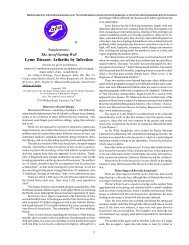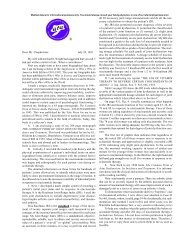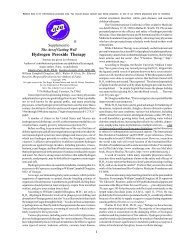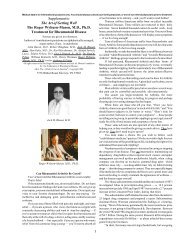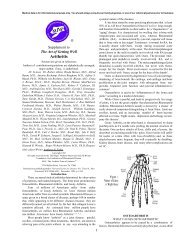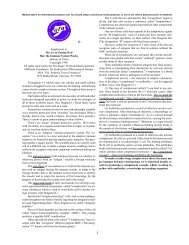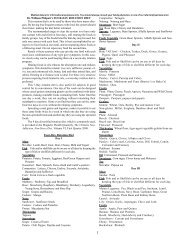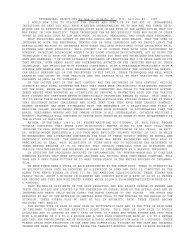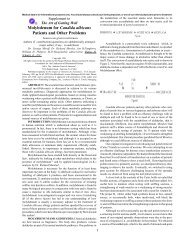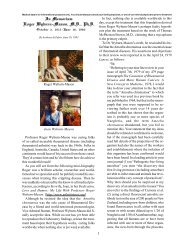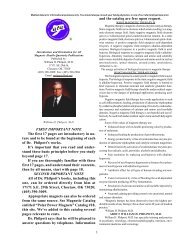June â 1994 â PDF - Arthritis Trust of America
June â 1994 â PDF - Arthritis Trust of America
June â 1994 â PDF - Arthritis Trust of America
You also want an ePaper? Increase the reach of your titles
YUMPU automatically turns print PDFs into web optimized ePapers that Google loves.
Osteoarthritis Treatment<br />
continued from page 1<br />
<strong>of</strong> pain and structural problems<br />
not <strong>of</strong>ten recognized -- and a<br />
possible solution for them which<br />
they called "Sclerotherapy."<br />
Later another referral physician,<br />
William J. Faber, D.O.<br />
mailed to the Foundation interesting<br />
literature related to a book,<br />
Pain, Pain Go Away, that he and<br />
Morton Walker, D.P.M. wrote<br />
on the subject.<br />
The subject <strong>of</strong> Pain, Pain<br />
Go Away 1 is the damage and pain<br />
caused by stretched, torn or otherwise<br />
disturbed tendons and<br />
ligaments. The treatment to restore<br />
proper functioning <strong>of</strong> these<br />
disturbed tendons and ligaments<br />
is called "Sclerotherapy" by Osteopaths,<br />
"Proliferative Therapy"<br />
by Medical Doctors and "Reconstructive<br />
Therapy" by Faber and<br />
Walker, and some other physicians.<br />
During the course <strong>of</strong> bodily<br />
disease, aging, sports accidents,<br />
or even chemical imbalances,<br />
there is <strong>of</strong>ten much damage to<br />
ligaments, tendons, muscles,<br />
joints and joint cartilage. This is<br />
also true during episodes <strong>of</strong> Rheumatoid<br />
Disease and also throughout<br />
Osteoarthritis. Much <strong>of</strong> this<br />
hidden damage has hitherto been<br />
unresolvable.<br />
It is possible, but not probable,<br />
that an arthritic will also<br />
suffer from Gout or what is <strong>of</strong>ten<br />
known as “Gouty <strong>Arthritis</strong>.”<br />
Short <strong>of</strong> the traditional treatments,<br />
which use several medicines<br />
and diet (restriction <strong>of</strong> purine<br />
containing foods) to control<br />
the disease, there are few alternative<br />
medical answers. I challenged<br />
the reader <strong>of</strong> The Art <strong>of</strong><br />
Getting Well to send me any alternatives<br />
they might know, and<br />
so Roydon Brown <strong>of</strong> the C.C.<br />
Pollen Co., Phoenix, AZ sent a<br />
substance, High Desert R Bee-JT<br />
Right Powder, containing a broad<br />
mixture <strong>of</strong> ingredients which he<br />
says will solve the gout problem.<br />
This is under personal trial at the<br />
moment.<br />
Those who have gouty arthritis<br />
have an inability to excrete<br />
as much uric acid crystals<br />
as they should through their urine.<br />
These undissolvable crystals precipitate<br />
out in joints, and create<br />
extreme pain each time one<br />
moves, like sharp, small needles<br />
lodged therein. Allopurinol is traditionally<br />
used to prevent the<br />
formation <strong>of</strong> these crystals.<br />
ColBENEMID R , containing a<br />
mixture <strong>of</strong> Probenecid and<br />
Colchicine, helps the body to<br />
eliminate the crystals. A combination<br />
<strong>of</strong> the two will halt the<br />
precipitation <strong>of</strong> the uric acid crystals,<br />
and also help to rid the body<br />
<strong>of</strong> the painful crystals.<br />
As an incidental, one <strong>of</strong> the<br />
drugs in ColBENEMID, colchicine,<br />
was serendipitously discovered<br />
to help the liver to heal.<br />
One type <strong>of</strong> joint pain that<br />
disturbs some <strong>of</strong> us greatly cannot<br />
be attributed any longer to<br />
active Rheumatoid Disease or<br />
Gout. Often this kind <strong>of</strong> pain is<br />
the result <strong>of</strong> having had Rheumatoid<br />
Disease or is medically<br />
identified as Osteoarthritis, and<br />
stems from the absence <strong>of</strong> cartilage,<br />
the friction <strong>of</strong> bone (clicking<br />
joints as we move them), or<br />
weakened tendons, ligatures and<br />
muscles where they should attach<br />
to bone surfaces through<br />
tearing, stretching or physical<br />
damage.<br />
Dr. Faber explains: “X-rays<br />
cannot show anything but bones,<br />
and do not show torn ligaments<br />
which stabilize joints by holding<br />
bones in place. When ligaments<br />
are torn they are unable to effectively<br />
function to hold bones in<br />
place which causes friction as<br />
bone rubs against one. [The<br />
body's structure and form is held<br />
together by the ligaments and<br />
tendons, not the muscles, which<br />
simply provide power across the<br />
equivalent <strong>of</strong> pulleys and levers<br />
in the body.]<br />
“The body attempts to correct<br />
this problem caused by the<br />
torn ligaments by creating “arthritis”.<br />
In this instance “arthritis”<br />
[including calcium spurs<br />
which create pain] is the body’s<br />
attempt to compensate for the<br />
torn ligament’s inability to hold<br />
the bones in place.<br />
“This,” says Faber, “explains<br />
why anti-inflammatory<br />
drugs and cortisone are <strong>of</strong>ten not<br />
effective. Excess friction, not inflammation,<br />
is the cause <strong>of</strong> the<br />
joint pain. Reducing inflammation<br />
will not eliminate the problem<br />
nor provide long-term relief.<br />
Only strengthening the ligaments<br />
will correct the problem.”<br />
Since ligaments contain no<br />
muscle fibers, exercise also will<br />
not correct the problem or provide<br />
long-term relief.<br />
When should “proliferative”<br />
therapy be considered<br />
According to Faber, under<br />
the following conditions.<br />
1. When ligaments are either<br />
lax or torn, then the ligaments<br />
can be strengthened.<br />
2. When any joint has pain<br />
lasting longer than six weeks. A<br />
healthy body should be able to<br />
heal torn or lax ligaments within<br />
six weeks. If joint pain persists<br />
beyond six weeks, it is an indication<br />
that the body has not been<br />
able to handle it on its own and<br />
that the joint is unstable from lax<br />
or torn ligaments.<br />
3. Any joint that is helped by<br />
a support or brace. A brace or<br />
support functions as ligaments<br />
do. That is, they function to stabilize<br />
the joint. If a support brace<br />
helps, proliferative therapy is<br />
indicated as it strengthens the<br />
ligaments, enabling the necessary<br />
support.<br />
4. Any joint that fails to respond<br />
to manipulation or adjustments.<br />
Many joint problems can<br />
be resolved with manipulations/<br />
adjustments and <strong>of</strong>ten manipulation/adjustment<br />
is the treatment<br />
<strong>of</strong> choice. Manipulation is highly<br />
effective when bones are out <strong>of</strong><br />
alignment as a result <strong>of</strong> bad posture<br />
or injury. When manipulation<br />
or adjustment doesn’t provide<br />
lasting relief it is because<br />
the ligaments are lax or torn and<br />
can’t hold the joint in place.<br />
5. Any joint that is worse<br />
after surgery. When injured joint<br />
spacers are removed in surgery<br />
(discs, cartilage) this causes the<br />
ligaments to become lax. This<br />
laxity causes the joint to become<br />
unstable and eventually form<br />
arthritis.<br />
6. Any joint that is better<br />
with rest and worse with exercise.<br />
Rest allows the body to heal<br />
itself and also reduces friction<br />
which is caused by a torn or lax<br />
ligament in a weakened joint.<br />
Exercise <strong>of</strong> an unstable joint<br />
makes it hurt more as it creates<br />
increased friction. Because <strong>of</strong><br />
the decreased blood supply in<br />
ligaments, rest alone is <strong>of</strong>ten not<br />
sufficient for the body to heal<br />
itself. And, because ligaments<br />
and tendons do not contain<br />
muscle fiber, exercise will not<br />
heal an injured ligament or tendon.<br />
7. Any popping, snapping<br />
or clicking joint. A joint that is<br />
unstable snaps, clicks or pops.<br />
Proliferative therapy causes<br />
strengthening <strong>of</strong> the ligaments<br />
and thus stabilizes the joint thus<br />
eliminating the popping, snapping<br />
and/or clicking.<br />
8. Any torn tendon or<br />
tendonitis that does not resolve<br />
after six weeks. Tendons are like<br />
ligaments in that they are fibrous<br />
tissue and they attach to the bone.<br />
They also have a lack <strong>of</strong> blood<br />
supply like ligaments, and therefore<br />
have a poor healing ability.<br />
Proliferative therapy causes a<br />
permanent strengthening <strong>of</strong> torn<br />
or lax tendons just as it does for<br />
torn or lax ligaments.<br />
In this form <strong>of</strong> treatment,<br />
medical specialists (M.D. or<br />
D.O.) <strong>of</strong>ten utilize x-ray, photographs<br />
and thermography (infrared<br />
mapping <strong>of</strong> body inflammation<br />
through heat sources). Such<br />
practitioners become very skilled<br />
at locating hot spots (inflammation<br />
and pain) by sense <strong>of</strong> touch,<br />
to confirm results <strong>of</strong> other tests,<br />
(continued on page 6)<br />
5



